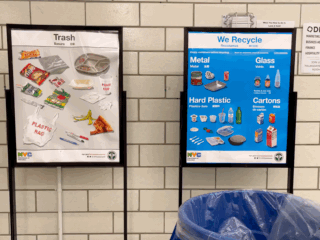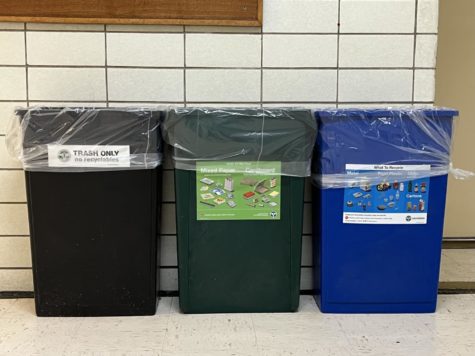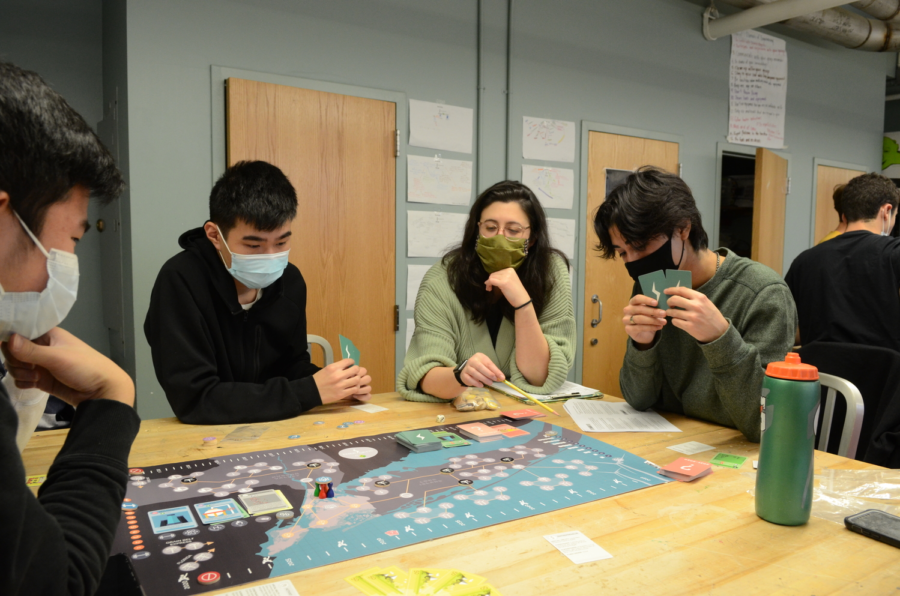Environmental Education: What Schools are Missing
Despite growing concerns about the environment, many schools fail to properly discuss sustainability.
Ms. Wax and students play a game about energy policy in the Green Design and Clean Technology class.
We have all been taught how to recycle, if not briefly from a teacher, then from the signs behind the trash bins. I mean, it seems easy enough. Throw your trash into the bin corresponding with its material. If it is a plastic bottle, throw it in the plastics bin. If it is paper, throw it in the paper bin. It is such a simple process, yet after dedicating a moment of our time to sorting trash, we are hit with a sense of pride.
“I’m helping the environment,” you may tell yourself, with a small smile on your face. Well, I hate to break it to you, but your actions may have caused more harm than good.
All New York City schools are required by law to recycle. So in any NYC school, we should be able to see three recycling bins each with either a green sticker, a white sticker, or a blue sticker informing students what garbage should go in each bin.
The green sticker indicates mixed paper and cardboard. The blue sticker indicates metals, rigid plastics, glass, and cartons. The white sticker is for everything else that does not fit in elsewhere.
Match the material of the garbage with the categories of trash depicted on the stickers. For milk, empty the carton and place it in the milk cartoon bin. This is how we were taught to recycle in school. But, this is not everything we needed to know; there is still one crucial step most of us are ignorant of.
In reality, in addition to being placed in the correct recycling bins, the recyclables need to be empty, clean, and dry in order to keep their value as a recyclable good.

Dirty or wet materials in the batch are likely to be removed from the recycling pile and sent to the landfills, completely undoing any environmental benefit one thought they were doing when they chose to recycle. Worse, dirty and wet materials can also contaminate and ruin the quality of other recyclables, exponentially increasing the negative effect of not cleaning items that should be recycled.
In order to avoid all of this trouble, opt to quickly clean and dry recyclables with a quick rinse so that no contents remain in the container and shake to remove any excess water before throwing them in their respective bins.
Despite it being an important and easy step in recycling, most of us are unaware of it because it was never taught in class. But climate change is real, and sustainability should be important enough to be taught properly in schools.
Luckily, this idea is not so obscure to NYC’s Department of Education (DOE). The DOE has already acknowledged the importance of sustainability by establishing an Office of Sustainability in 2009 and including a greater emphasis on climate change in their new learning standard guideline, the Next Generation Science Standards. Additionally, according to a survey by the National Public Radio (NPR) and Ipsos, a market research firm, 86% of K-12 teachers support climate change education in U.S. schools.
“I feel like the point of school is to prepare students for the future, and we all need to learn how to protect the environment, live in harmony with ecosystems, and learn reciprocity, or we are in serious trouble as a species,” said Ms. Rachel Wax, a teacher of the Green Design and Clean Technology class at Bronx Science.

As of now, most of the environmental knowledge students possess is from their own independent research. However, with the hustle and bustle of school life, not many students take it upon themselves to learn more about this topic. “Not enough students care about or are informed on this topic,” said Dredheza Gashi Baraliu ’23.
Therefore, learning about sustainability should be a priority in the classroom. “Learning about this subject makes students more equipped to handle the effects of climate change and make environmentally conscious decisions,” said Emma Afful ’22.
We have already been exposed to some environmental awareness with the rise in popularity of thrifting, gardening, reusable straws and water bottles, upcycling, and much more. Although these may be considered fads that are here one day and gone the next, even the tiniest bit of exposure can go a long way.
“It has brought more people into the environmental movement and made them more aware of some of their damaging habits,” said Afful. In the long run, this invaluable knowledge will help everyone become more conscious in this world that we co-exist in.
So go out there and advocate for environmental conservation classes and awareness in your school and workplace. Talk to your teachers and administration to see what policies can be implemented to go beyond just the three: reuse, reduce, and recycle. And please, remember to clean your recyclables before tossing them in the bin.
“How cool it would be to have a class where students could take their content knowledge from other courses and learn about real world issues and explore solutions,” said Ms. Rachel Wax
Miaoting Zhen is a Managing Editor/Advisory Editor for ‘The Science Survey.’ She finds journalistic writing appealing because of its informative yet...
Wei Ni Zhang is a News Editor for the ‘The Science Survey.’ She finds journalistic writing to be most appealing given that it allows for different...
Nicole Zhou is the Editor-in-Chief for ‘The Observatory' yearbook and a Staff Reporter for 'The Science Survey' newspaper. This is her third year revising...

